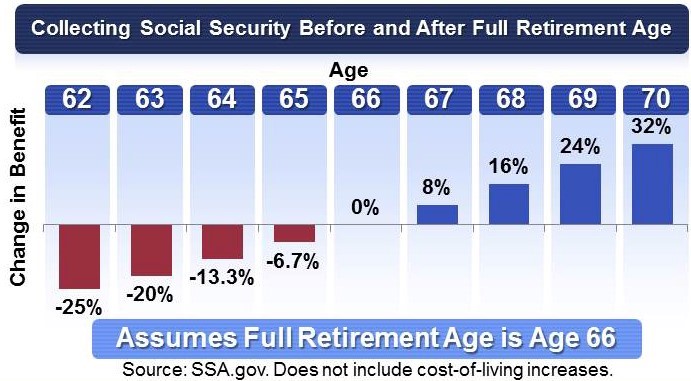For those of you who have been paying into Social Security for your entire working careers, the day when you finally retire and begin receiving your Social Security benefits is likely going to be a happy one.
But for many, electing to receive benefits as soon as they retire may leave money on the table over their lifetime.
This article will outline some basic Social Security information as well as a couple of strategies to help you decide when you should start receiving benefits in order to maximize the payout over your lifetime. Benefit timing is situational and there is no “one size fits all” approach.
Basic Information
We recommend that all clients go to the Social Security website and create a “my Social Security” account as soon as possible. Once you’ve created an account, you will be able to view your Social Security record including your earnings history and estimated benefits as well as apply for benefits. You will also need to create an account in order to apply for and elect Medicare coverage once you reach age 65.
Here is the link to create your “my Social Security” account:
https://www.ssa.gov/site/signin/en/
In order to be eligible for any Social Security retirement benefits, you must have paid into Social Security for 10 years, equivalent to 40 quarters worth of “credits”. Each quarter you work and pay Social Security taxes, you earn one credit. The quarters do not have to be consecutive, but you will receive $0 retirement benefits if you have not accrued the full 40 credits – there is no pro-rata adjustment for benefits.
The amount of benefit you receive will be calculated based on the highest 35 years of earnings and varies depending on how much you earn and when you choose to start benefits. If you have worked for less than 35 years, all earning years will be included in the calculation and any years not worked up to 35 will be considered $0 earnings in the calculation of benefits. On average, retirement beneficiaries receive 40% of their pre-retirement income from Social Security. Because Social Security replaces less than half of regular income, Social Security should not be the only source retirees rely on for their retirement livelihoods. The amount of Social Security benefit increases by 8% each year that benefits are delayed passed Full Retirement Age (FRA) up to age 70. If benefits are elected before FRA (as early as age 62), the benefit amount will be reduced as outlined in the chart below[1]. The FRA for most people is currently 66-67 years old.
Break-Even Analysis
Because the amount of benefit increases or decreases depending on when benefits are elected, there is a cost-benefit / break-even analysis to be done. Based on the example in the chart below[2], if your benefit at age 62 would be $23,904 per year, but your benefit if delayed until age 70 would be $42,684 per year, during those 8 years of postponed benefits between age 62 and age 70, $191,232 (8 years at $23,904) of benefits would be given up by not receiving any benefits during that time. It would therefore take you 10.2 years of receiving the higher benefit received at age 70 (an additional $18,780 per year at the $42,684K benefit level) to break-even. At that point, you would be 80-81 years old[3]. Any additional years lived past the break-even point would make it profitable to have postponed benefits; for example if this person lived to age 85, they would have gained an additional $93,900 by postponing benefits from age 62 to age 70 over the course of 5 years. This means that part of the cost-benefit analysis is a bet on your own life expectancy in addition to your financial ability to postpone.
Note that this analysis does not consider that if you postpone benefits, you would likely draw those funds from your asset base (brokerage or retirement accounts) to fund your lifestyle and therefore lose the possible benefit of market return on those funds. When you consider that taking social security allows you to leave more of your current funds invested and assume they continue to grow with the market, the break-even age pushes out even further.
Survivor Benefit
For couples where there is a large disparity in the level of benefits to be received between spouses, or only one spouse is eligible for benefits, there are additional considerations related to the Surviving Spouse Benefit and the Spousal Benefit.
When one spouse passes away, the surviving spouse is entitled to 100% of the deceased spouse’s benefit. If the surviving spouse is also receiving a benefit, the benefit to the surviving spouse will increase to the level of the deceased spouse’s if the deceased spouse’s benefit was greater. If the deceased spouse’s benefit was less than the surviving spouse’s benefit, then the surviving spouse would continue to receive their regular benefit – there is no “doubling-up” of benefits when one spouse passes. For example, in a household where one spouse receives $40K per year benefit and the other spouse receives $20K benefit, if the spouse with the $40K benefit passes, the surviving spouse’s benefit will increase from $20K to $40K; however the household benefit will decrease from the combined $60K benefit to the singular $40K benefit.
Because of this, depending on the health of the couple, there is an incentive to max-out the higher-earner’s Social Security benefit by postponing receipt of benefits for the higher-earner past FRA so that the survivor benefit is also maxed-out. If one or both spouses are expected to live at least an average life (it doesn’t matter which one), then this strategy makes sense. Both spouses should delay benefits past FRA only if both spouses are in excellent health and expected to live a much longer than average life (into 90s). If both spouses are in poor health, then time is of the essence and neither should delay benefits.
When the higher-earner delays benefits, there is less incentive for the lower-earner to delay benefits and the lower-earner should consider taking benefits at FRA or earlier. This is also potentially a hedge of the risk that the life expectancy of the surviving spouse will not be as long as expected.
Spousal Benefit
For couples where only one spouse is eligible for Social Security benefits, the opportunity cost of postponing benefits is much higher. Non-eligible spouses are entitled to a spousal benefit (separate from Surviving Spouse benefit) up to 50% of the eligible spouse’s benefit while both are living, as long as the non-eligible spouse is at least 62 years old (decreased benefit if non-eligible spouse starts receiving spousal benefit before his/her FRA). For example, if the eligible spouse’s benefit is $2,000 per month, the non-eligible spouse would be entitled to an additional $1,000 spousal benefit, resulting in a total combined benefit for the household of $3,000 per month. The non-eligible spouse cannot elect to receive the spousal benefit until the eligible spouse has started to receive their benefit. Therefore, if the couple elected to delay the eligible spouse’s benefit, the opportunity cost of delaying would be $3,000 per month instead of just the eligible spouse’s $2,000 and would delay the break-even point to much later. Once the eligible spouse passes away, the surviving non-eligible spouse will receive the Surviving Spouse benefit discussed above. If the non-eligible spouse predeceases the eligible spouse, the spousal benefit is eliminated. For applicable couples, the partial spousal benefit must be included in the break-even analysis.
Recap
In conclusion, all retirees should perform a cost-benefit / break-even analysis to determine when they should start receiving Social Security benefits based on their financial situation and their life expectancy.
For many clients, it is likely preferable to wait to receive benefits until at least FRA; however, because the break-even point is pushed back when there is an assumed return on the funds left in investment accounts, it is not always a no-brainer to postpone until age 70.
If there is a large disparity between the benefit levels of spouses, and one or both spouses are expected to live at least an average lifespan, then it is statistically beneficial for the spouse with the greater benefit to delay and max-out their benefits as long as possible as to increase their benefit and the survivor benefit. The lower-earner may begin their benefit at FRA or earlier depending on their unique situation.
If only one spouse is eligible to receive Social Security retirement benefits, the spousal benefit must be included in the cost-benefit analysis to determine the break-even point.
Please note that there are some additional restrictions to these benefits based on age and length of marriage. This type of analysis and strategic advice is part of all of AMM’s Financial Plans. If you have any questions or would like this type of analysis for your personal retirement situation, please call or email us and we would be happy to discuss our financial planning services with you.
[1] https://artofthinkingsmart.com/social-security-frequently-asked-questions/
[2] https://artofthinkingsmart.com/social-security-frequently-asked-questions/
[3] Note this does not account for earnings lost on funds taken out of retirement accounts to fund basic living




